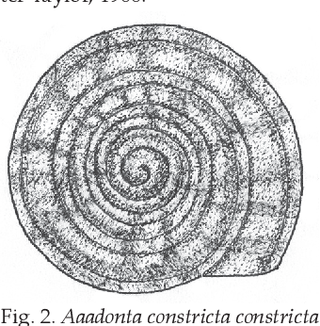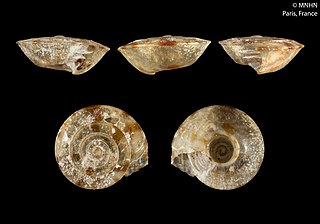Aaadonta angaurana is a small air-breathing land snail, a terrestrial pulmonate gastropod mollusc in the family Endodontidae.

Aaadonta is a genus of air-breathing land snails, terrestrial pulmonate gastropod mollusks in the family Endodontidae. Specimens from this genus are endemic to Palau.

Aaadonta constricta is a species of land snail, a terrestrial pulmonate gastropod mollusk in the family Endodontidae. It is endemic to Palau, where it is known from the islands of Babeldaob, Ngemelis, Peleliu and Koror. It may be extirpated from Koror. It is threatened by habitat destruction and modification.

Aaadonta fuscozonata is a species of air-breathing land snail, a terrestrial pulmonate gastropod mollusc in the family Endodontidae. This species is endemic to Palau, where it is known from Koror and Peleliu, and the small islands of Ngemelis and the northern Rock Islands. This snail inhabits tropical moist lowland forest, and is threatened by the destruction and modification of its habitat.
Aaadonta irregularis is a species of snail, a terrestrial pulmonate gastropod mollusk in the family Endodontidae. It is endemic to Palau, where it was only known from Peleliu, but has only been found recently on the very small island of Omekang. It is threatened by the destruction and modification of its tropical moist lowland forest habitat.
Aaadonta kinlochi is a species of snail, a terrestrial pulmonate gastropod mollusk in the family Endodontidae. It is endemic to Palau, where it was known from Angaur and Ulong Island. If it is still extant, it is threatened by the destruction and modification of its tropical moist lowland forest habitat.
Aaadonta pelewana is a species of snail, a terrestrial pulmonate gastropod mollusk in the family Endodontidae. It is found in Palau, where it was known from Peleliu and Koror. If it is still extant, it is threatened by the destruction and modification of its tropical moist lowland forest habitat.

Endodontidae is a taxonomic family of very small air-breathing land snails and slugs, terrestrial pulmonate gastropod molluscs in the superfamily Punctoidea.

Cookeconcha is a genus of small air-breathing land snails, terrestrial pulmonate gastropod mollusks in the family Endodontidae.

Endodonta is a genus of small air-breathing land snails, terrestrial pulmonate gastropod mollusks in the family Endodontidae, an endemic family of land snails from the Hawaiian islands.
†Pseudohelenoconcha was a genus of air-breathing land snails, shell-less terrestrial pulmonate gastropod mollusks in the subfamily Trachycystinae of the family Charopidae.
Orangia is a genus of small air-breathing land snails, terrestrial pulmonate gastropod mollusks in the family Charopidae or in Endodontidae.

Camaenidae is a family of air-breathing land snails, terrestrial pulmonate gastropod mollusks in the superfamily Helicoidea, the typical snails and their allies. This is one of the most diverse families in the clade Stylommatophora.
Zyzzyxdonta alata is a species of air-breathing land snail, a terrestrial pulmonate gastropod mollusk in the family Endodontidae.

Libera is a genus of air-breathing land snails, terrestrial pulmonate gastropod mollusks in the family Endodontidae.
George Alan Solem, known professionally as Alan Solem, was an American malacologist, a biologist who studied mollusks.

Notodiscus hookeri is a species of small air-breathing land snail, a terrestrial gastropod mollusk in the family Charopidae. This snail lives on islands in the sub-Antarctic region. Its shell is unique among land snails in that the organic shell layers contain no chitin.
Aaadonta fuscozonata depressa is a subspecies of land snail, a terrestrial pulmonate gastropod mollusk in the family Endodontidae. It is endemic to Palau, where it was only known from the tropical moist lowland forests of Peleliu. It is threatened by destruction and modification of its habitat.
Ba humbugi is the only species and therefore the type species in the genus Ba, a genus of land snail, belonging to the family Charopidae. Both the genus and the species were named by the American malacologist Alan Solem. The genus is endemic to the Fijian island of Viti Levu, and B. humbugi is an endangered species.

Kleokyphus is a genus of small air-breathing land snails, terrestrial pulmonate gastropod mollusks in the family Endodontidae, an endemic family of land snails from the Hawaiian islands.








